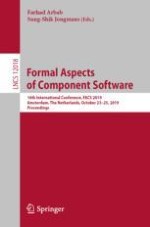This book constitutes the thoroughly revised selected papers from the 16th International Conference on Formal Aspects of Component Software, FACS 2019, held in Amsterdam, The Netherlands, in October 2019.
The 9 full papers presented together with 9 full papers and 3 short papers as well as 2 other papers were carefully reviewed and selected from 27 submissions. FACS 2019 is concerned with how formal methods can be used to make component-based and service-oriented software development succeed. Formal methods have provided a foundation for component-based software by successfully addressing challenging issues such as mathematical models for components, composition and adaptation, or rigorous approaches to verification, deployment, testing, and certification.

 ), and providing a decomposition technique, we enable compositional verification of Simulink models with interacting components. This enables us to use the interactive theorem prover KeYmaera X to prove the correctness of hybrid control systems modeled in Simulink, which we demonstrate with an automotive industrial case study.
), and providing a decomposition technique, we enable compositional verification of Simulink models with interacting components. This enables us to use the interactive theorem prover KeYmaera X to prove the correctness of hybrid control systems modeled in Simulink, which we demonstrate with an automotive industrial case study.